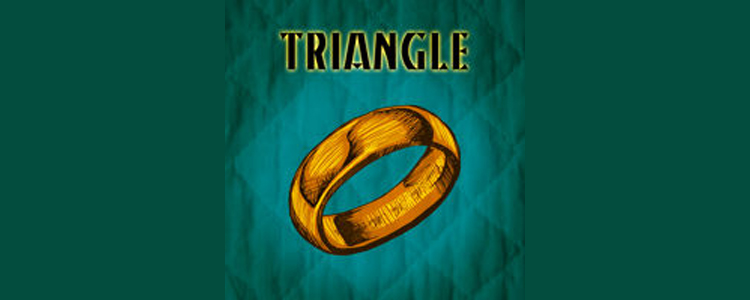This month, we check in with alumni Curtis Moore and Thomas Mizer, as they tell us about the upcoming production of 2012 Festival show, Triangle, at TheatreWorks Silicon Valley.
Two love stories, set in the same New York City building but a hundred years apart, weave together across the century as long buried secrets are uncovered and ghosts of the past begin to influence the future.
Last time we checked in with Triangle, you were preparing for your first on-its-feet production at Lyric Theatre of Oklahoma City. How was that experience, working with the team in OKC?
The workshop production at Lyric was a dream come true. Truly. Their technical facilities are first-rate, and the staff and actors were passionate advocates for the piece. It was the theater’s first experience working on a new musical so we were all learning and growing together. They, and the city as whole, embraced the show with a dedication that was inspiring. Even walking into a local store, people would find out why we were in town and they’d know about the show and be excited and proud that OKC was creating something. Some people would say they were coming again and bringing friends because they loved it so much. How special is that to feel like an entire community wants to collaborate on a new musical! (And believe us, the clerk at the OKC wine store definitely had an important role in the development of the show.)
What did you learn about the show once it got on its feet?
The musical moves back and forth through time and has actors playing characters in both time periods, sometimes transitioning between the two characters in front of the audience from one line to the next. We worried that this kind of complexity might be confusing in production. On the contrary, we learned that the audiences had no problem making sense of the unconventional structure. In a reading, someone can simply read the stage direction “1911, Factory” and we get it. But here, we had to make sure that the transitions made sense without those cues, that the audience was able to keep track of the characters. And, thanks to our great collaborators, they did.
We also discovered that the show was funnier than we thought. We always wanted it to be emotional and moving, but not a sepia-toned, depressing period piece. It’s sexy and fun and fresh in ways that came to life through the actors being alive with each other on stage. We’ll never forget getting a text from one of the actors after we’d left OKC but the show was still running. She wrote during intermission because the cast was giggling backstage over the fact that the show was getting “Neil Simon laughs.” Now, we’ll assume she was exaggerating just a wee bit…but for a show about seemingly dark issues, it was wonderful to find out that we had hit our mark and that the show was full of life. (Plus, if you make people laugh and like the characters, they’re going to cry like babies when you put them through the wringer in the end. We’re so mean…)
What changes were made to the show in that process?
So much changed. The director Michael Baron was adamant that we focus on story, story, story. If it wasn’t clear, then we had to work on it. It was not only about big changes like the best time to switch from one time period to another (rearranging the order of scenes), but also about small things like editing and clarifying lines to make sure that necessary “clues” for the mysteries or information about the backstories of our characters were handled succinctly without feeling like big hunks of exposition.
We also wrote an entirely new opening sequence with two new songs that welcome us into our lead character’s world. Again, it was about creating a sense of life and humor to engage us with our lead before things take darker turns.
Finally, we added a full orchestration which…well…yeah, it’s hard to even put into words the joy of hearing that first run-through with a six-piece orchestra led by the incredible James Sampliner. It’s a lush musical with elements of pop; to finally have those colors, colors that help delineate the two time periods, was like adding a whole new character.
You are now preparing for its World Premiere at TheatreWorks in Silicon Valley this summer. What are you looking forward to exploring and changing for this next step in its development?
I think our focus is on two things. First, we walked away from OKC with a ton of great feedback. The audiences filled out survey cards and participated in talkbacks after every show. Every show! And not just two or three people, but a large part of the audience. They gave us very practical, simple things that we can tweak and look at. The structure of the show feels solid; it’s all about detail work now. Secondly, now that we know the story works, we want to look at where we can lift the show, find those moments of theatrical magic in staging and lights and sound that will heighten the emotions. In a way, it is a ghost story at heart and we really want to look at how we can use theater techniques to envelop people in a mysterious, romantic, magical world.
Why should everyone come out to Palo Alto this summer to see Triangle?
Have you been to Palo Alto?! That’s reason enough. Our show is just the icing on a beautiful, California summer cake. Honestly, the piece has grown and deepened so much thanks to all the NAMT partners who have nurtured it along the way. It’s like we are finally sending our child off to college and we want everyone to be a part of that special moment. Ultimately, you should come because it’s an entertaining night of theater, a story everyone can relate to about letting go and loving again. You’ll laugh, you’ll cry, you’ll hear some amazing actor/singers and, at the end of the show, you’ll want to reach out to the people you care about and tell them how much they mean to you. And you know your Mom is waiting for that call…
For more information about TheatreWorks Silicon Valley’s upcoming production of Triangle, visit the TheatreWorks website.


